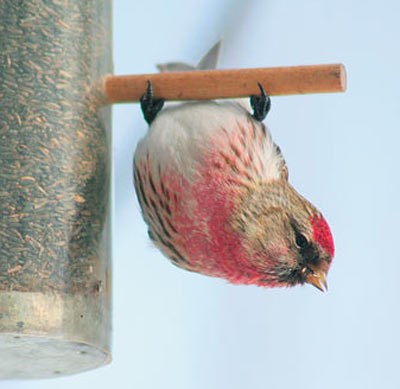By Chris Blomme
As an avid member of the executive for the Sudbury Ornithological Society and a life-long bird watcher, I get asked many questions pertaining to the avian life of our local birds. This winter has not yet been known for its deep snow or strange cold or mild spells, which often help explain what species might be here or what species may be absent. Lately I have been getting questions from curious observers who maintain feeders in their back yards. It is not the usual “what are these birds,” but rather “where are the birds?”
Last year was a particularly interesting year for a small sparrow-like finch called the common redpoll. They were literally everywhere and people who maintained tube feeders of niger seeds in particular had these birds visiting in droves.
Northern Life had several photographic features of this bird during the course of the winter of 2008 from local feeder watchers.

Last year was a peak year for common redpolls and their mass movements.
Michael Kavanagh,
Member of the Sudbury Ornithological Society
The female lays eggs and incubates at a nest for several weeks and therefore as evolution may dictate, she is less brightly coloured in the rose sector and blends in well with more drab backgrounds. She does however, have a dull red poll as well. Last year’s Christmas bird count in Sudbury revealed hundreds of common redpolls. This year’s count, on Dec. 27, 2010, revealed only six birds.
This brings me to the original question from one of our local bird feeder watchers. Where are the birds? Last year was a peak year for common redpolls and their mass movements. This is called an irruptive behavior and can be seen in evening grosbeaks, pine grosbeaks, pine siskin, American goldfinch and a few other species that we often see at our feeders over time. Irruptive species are often associated with Boreal forest seed crops in such species as white birch, alders, willows, and conifers like balsam fir and black and white spruce. The presence or absence of these seeds further north will often dictate the geographical area that the finches will frequent based on the presence of the seeds, their main food.
Having a maintained feeder in your backyard is a ready supply of food for foraging finches, and when they “invade” our area, few can turn down the offerings of easy “pickings” particularly Niger seeds. Last year there were people who often told me their tube feeders had to be filled daily, where as this year people are noting that their bird seed is sitting idle. Some of this may change as the winter progresses. It is hard to predict what might become common in a given winter until they arrive. There is some suggestion that redpolls have an east-west movement and a two year cycle. Just be patient and keep the feeders stalked with fresh seed. At worst the spring migration with its returning birds will clean up the feeders rapidly. Migrating birds require lots of energy to make those flights. But that is another story.
Chris Blomme is a member of the Sudbury Ornithological Society.
